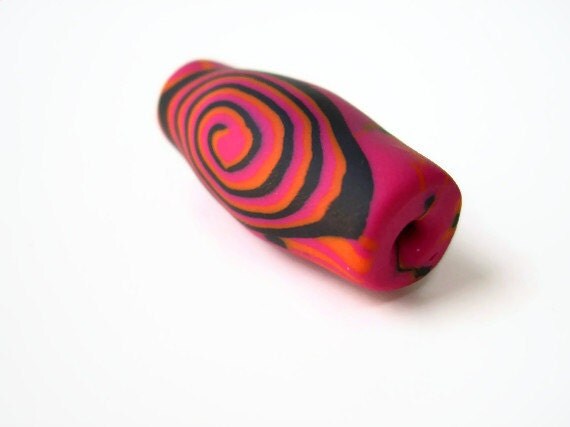Several years ago I switched from using Fimo Classic to Sculpey Premo!. Although I like FC for many things, I found it very hard to condition and at the time I was suffering from RSI so also found it quite painful to knead the stiff clay. I hung on to my Fimo stash, but switched to the softer Premo! for almost everything. I had almost forgotten I had the Fimo until a couple of weeks ago when a customer commissioned me to make some earrings to match one of the older focal beads in my Etsy shop. I wanted the earrings to match exactly, so I knew I would have to use the same brand of clay to make them (actually, the same
packet of clay as it turned out). So I dug out the Fimo and this is what I found...
The clay was rock hard and very crumbly. It was impossible to work. In fact, it was so hard that I wondered if I would even be able to use it. But I had a block of MixQuick in my toolbox and an order to fill, so I had nothing to lose.
You can see how dry the original clay was. In fact since I tend to use Sculpey additives with Premo!, the MixQuick was quite dry too!
I chopped the pink Fimo Classic into thin slices and let it crumble. This is quite a messy technique, so make sure you work on a large tile and that you lay plastic on the floor if you have carpet or you'll be picking crumbs of clay out of the shag pile forever.
I started with about a third MixQuick and chopped it up along with the Fimo Classic.
Close up.
It stayed very crumbly for a long time and was very hard to work. I had to rub the mix through my fingers as if I were rubbing fat into flour to make pastry. I rubbed then squeezed the mass together, then rubbed some more. I tried to manipulate the clay as much as possible but I think Fimo reacts to heat rather than manipulation (unlike Premo! which becomes softer as it is worked). I added a little more MixQuick but kept the proportions 2:1 Fimo:MixQuick.
Eventually the mass started to come together. Most of the clay held together in a ball with just a few crumbs. I could see that the MixQuick and the Fimo Classic were not thoroughly mixed as the colour was streaky.
Finally, I could roll the clay well enough to make snakes, which I chopped up and recombined to help it mix. Miraculously, by the time the streaks were gone, the pink clay was a workable consistency! I did the same with a batch of orange in an equally crumbly state and it came out just the same, so it could be done with the rest of my clay just as successfully.
This is the bead I copied and I was amazed that the earrings were a perfect colour match and the clay was good enough to make a jelly roll cane and form barrel beads.





















